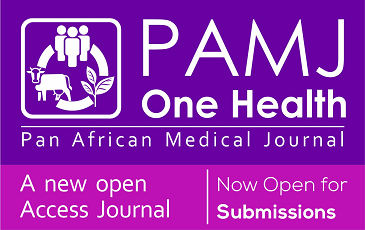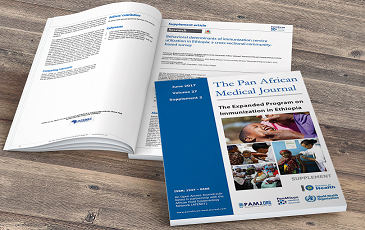Small bowel diverticulosis causing intestinal obstruction: a case report
Philemon Kwame Kumassah, Victoria Sena Gawu, George Darko Brown, Kwabena Agbedinu, Antoinette Asiedua Afua Bediako-Bowan
Corresponding author: Philemon Kwame Kumassah, Department of Surgery, Korle Bu Teaching Hospital, Accra, Ghana 
Received: 24 Dec 2024 - Accepted: 02 Mar 2025 - Published: 14 Mar 2025
Domain: General surgery
Keywords: Small bowel diverticulosis, intestinal obstruction, case report
©Philemon Kwame Kumassah et al. PAMJ Clinical Medicine (ISSN: 2707-2797). This is an Open Access article distributed under the terms of the Creative Commons Attribution International 4.0 License (https://creativecommons.org/licenses/by/4.0/), which permits unrestricted use, distribution, and reproduction in any medium, provided the original work is properly cited.
Cite this article: Philemon Kwame Kumassah et al. Small bowel diverticulosis causing intestinal obstruction: a case report. PAMJ Clinical Medicine. 2025;17:24. [doi: 10.11604/pamj-cm.2025.17.24.46325]
Available online at: https://www.clinical-medicine.panafrican-med-journal.com//content/article/17/24/full
Small bowel diverticulosis causing intestinal obstruction: a case report
![]() Philemon Kwame Kumassah1,&, Victoria Sena Gawu1, George Darko Brown1, Kwabena Agbedinu1,
Philemon Kwame Kumassah1,&, Victoria Sena Gawu1, George Darko Brown1, Kwabena Agbedinu1, ![]() Antoinette Asiedua Afua Bediako-Bowan1,2
Antoinette Asiedua Afua Bediako-Bowan1,2
&Corresponding author
Small bowel diverticulosis is a rare condition that is usually seen in the elderly. They are usually asymptomatic or may present with non-specific abdominal pain which may make the diagnosis elusive. Some patients are diagnosed incidentally during a contrast study of the gastrointestinal tract while others may present with complications such as bleeding, perforation or intestinal obstruction. Definitive treatment is by resection of the affected bowel segment and primary anastomosis. This report is a case of an elderly man who presented with acute intestinal obstruction. At laparotomy, he had multiple jejunal diverticula with an adhesive band across one diverticulum causing intestinal obstruction.
Intestinal diverticulosis refers to mucosa and submucosa outpouchings through weak points in the intestinal wall [1]. Diverticula are common in the colon but rarely seen in the small bowel. They develop because of high intraluminal pressures from peristaltic abnormalities or intestinal dyskinesia causing outpouchings at the potentially weak sites where the mesenteric vessels penetrate the bowel wall [2,3]. Diverticula are classified as true diverticula if they involve all the layers of the bowel such as Meckel's diverticulum or false diverticula if they involve only the mucosa and submucosa [4]. Small bowel diverticula are additionally classified based on the anatomic location as duodenal, jejunal or ileal. Duodenal diverticula occur in about 22% of the population and patients above 50 years of age [5]. Jejunoileal diverticula are seen in 1.3% of the population with the patients usually above the age of 60 years [2]. Small bowel diverticula can be extraluminal where it protrudes outside the bowel wall or intraluminal where an inward invagination of the bowel wall results from a congenital web across the bowel lumen [4].
Small bowel diverticula are usually asymptomatic; though 10-30% of patients may present with complications such as bleeding, diverticulitis, malabsorption, intestinal obstruction or perforation [1,4]. Double-contrast barium meal and follow-through, enteroclysis and abdominal computer tomographic (CT) scan can be used to outline the diverticula. Some diagnoses are however made incidentally during laparoscopy or laparotomy [1,2]. Patients with asymptomatic diverticula are managed conservatively. However, those who develop complications such as bleeding, intestinal obstruction or perforation may require surgery. We report a case of jejunal diverticula in an elderly man who presented with symptoms and signs suggestive of intestinal obstruction.
Patient information
An 88-year-old man, presented with 4 days history of colicky abdominal pain. The pain started in the central abdomen and later became generalized. There was associated bilious vomiting, obstipation, and progressive abdominal distension. He had no previous abdominal surgeries, no ventral wall hernias and no history of altered bowel habits or hematochezia. He had no family history of malignancy. He had lost about 5kg of weight over the past three months. Over the past five years, he had complained of epigastric pain, worsened with meals, and was managed for peptic ulcer disease, though not confirmed with an upper gastrointestinal endoscopy. He was hypertensive and well-controlled on antihypertensives.
Clinical findings
On examination, he was afebrile with temperature of 36.2°C, anicteric, mildly pale and moderately dehydrated. His blood pressure was 131/85 mmHg and had a pulse rate of 128 beats per minute. His abdomen was grossly distended, mildly tender in the epigastrium but no guarding or rebound tenderness. No masses were palpated within the abdomen. The bowel sounds were increased in frequency and pitch on auscultation. Per rectal examination revealed an empty rectum.
Timeline of current episode
November 2023: patient presented to the emergency room with above symptoms. November 2023: surgery was done and patient discharged. November 2024: last follow-up and discharge from clinic.
Diagnostic assessment
An erect and supine abdominal X-ray showed dilated loops of jejunum with multiple air-fluid levels suggesting intestinal obstruction (Figure 1). Blood electrolytes revealed hyponatremia of 128 mmol/l.
Diagnosis
A diagnosis of acute intestinal obstruction from small bowel tumor was made. However, the possibility of intestinal obstruction from adhesions was considered.
Therapeutic interventions
He was resuscitated with intravenous fluids to correct dehydration and hyponatremia and prepared for emergency laparotomy. Findings at laparotomy were multiple jejunal diverticula (Figure 2) with one diverticulum caught in an adhesive band (Figure 3) causing jejunal obstruction approximately 50 cm from the ligament of Treitz. The diverticula spanned 30 cm of the jejunum, including the site of obstruction, and hence a segmental jejunal resection and end-to-end jejuno-jejunal anastomosis was done. The duodenum, ileum and colon were however free of diverticula.
Follow-up and outcome of interventions
Post-operatively, he developed ileus which resolved on post-operative day 5 and was discharged on post-operative day 7. Histopathological examination of the resected specimen showed sections of small bowel with edematous wall, congested blood vessels and foci of mucosal sloughing. There were foci of herniation of mucosa and submucosa through the muscularis propria at the mesenteric border with the largest measuring 50 x 40 mm. He is currently well one year after the surgery and has not required any further treatment.
Patient perspective
The patient was satisfied with the treatment received.
Informed consent
The patient gave informed consent to publish this case report.
Jejunoileal diverticula are usually seen in the elderly with a male preponderance and are more common in the jejunum than the ileum [1]. This report was of an 88-year-old male who presented with jejunal diverticula. Jejunal diverticula are usually multiple and large especially in the proximal jejunum as seen in this report where the patient had five huge jejunal diverticula, largest been 50 x 40 mm [6]. The diverticula in this patient were false diverticula since the herniation at histopathological assessment involved only the mucosa and submucosa.
Small bowel diverticula are usually asymptomatic. However, patients who develop symptoms commonly present with non-specific epigastric pain which is misdiagnosed as dyspepsia [1]. The case in hand had presented several times to a healthcare facility with complaints of recurrent epigastric pain and had been managed for peptic ulcer disease. Edwards et al. documented the most common clinical symptom of small bowel diverticula as flatulent dyspepsia, with the patients presenting with vague abdominal pain mainly in the epigastrium or left hypochondrium one to two hours after meals and associated flatulence [3].
Patients may present with complications such as bleeding, manifesting as hematochezia or melena; iron deficiency anaemia from malabsorption or obscured bleeding; diverticulitis presenting with fever and localized tenderness; mechanical intestinal obstruction from adhesions or stenosis due to recurrent diverticulitis; peritonitis from perforation or localized abscess [1]. This patient presented with acute intestinal obstruction from an adhesive band constricting a section of the jejunum. Though he did not present with gastrointestinal bleeding, the histopathological assessment showed mucosal sloughing and venous congestion, which if unattended, he may have eventually presented with bleeding. Other complications include flatulence and bloating as a result of bacterial overgrowth from the blind loop created by the diverticula [7].
For complicated small bowel diverticula, a plain radiograph of the chest may show free intraperitoneal air suggestive of perforation, or multiple air-fluid levels and bowel distension on an abdominal radiograph suggestive of intestinal obstruction as seen in this report where the abdominal radiograph was suggestive of jejunal obstruction. A double-contrast barium meal and enteroclysis can be used to demonstrate the mucosal out-pouching, though their use is contraindicated in emergency situations such as acute diverticulitis or perforation [1]. These diverticula have also been detected as incidental findings when capsule endoscopy has been used to investigate other gastrointestinal lesions or occult gastrointestinal bleeding [1]. Abdominal computed tomography scan can be used in uncomplicated cases to outline the diverticula and in complicated cases to diagnose a localised abscess or phlegmon, pneumoperitoneum, and intestinal wall thickening due to inflammation [1]. Double-balloon enteroscopy may be used to diagnose small bowel diverticula and also has the advantage of offering intervention to stop bleeding from complicated diverticula [8].
Asymptomatic diverticula are usually managed conservatively [4]. Some authors recommend conservative management for patients with chronic symptoms [9]. However, jejunoileal diverticula are associated with a higher likelihood of complications such as perforation or abscess formation and hence, may warrant a more aggressive surgical approach for symptomatic patients to avoid the postoperative risk associated with emergency surgery when the diverticula become complicated [10]. Acute diverticulitis is managed with intravenous fluids, diet restriction and antibiotic therapy [4]. Complications such as intestinal obstruction, intestinal perforation and abscess formation require immediate surgery to resect the affected bowel segment and restore bowel continuity with a primary anastomosis [1].
Jejunoileal diverticula is a rare condition, and one must have a high index of suspicion to make the diagnosis. If the diagnosis is delayed, patients may develop complications such as intestinal obstruction, perforation, or bleeding which may result in significant morbidity. Our patient was not diagnosed until he presented with a complication of intestinal obstruction.
The authors declare no competing interests.
Patient management: Philemon Kwame Kumassah, Victoria Sena Gawu, George Darko Brown, Kwabena Agbedinu, Antoinette Asiedua Afua Bediako-Bowan. Manuscript drafting: Philemon Kwame Kumassah. Manuscript revision: Philemon Kwame Kumassah, George Darko Brown, Antoinette Asiedua Afua Bediako-Bowan. All the authors read and approved the final version of this manuscript.
Figure 1: erect and supine abdominal x-rays showing multiple air fluid levels and dilated loops of jejunum
Figure 2: A) multiple jejunal diverticula at the mesenteric border (white arrows); B) giant jejunal diverticula discovered incidentally at laparotomy (white arrows)
Figure 3: adhesive band arising from the area of jejunal diverticulum causing intestinal obstruction (white arrow)
- Falidas E, Vlachos K, Mathioulakis S, Archontovasilis F, Villias C. Multiple giant diverticula of the jejunum causing intestinal obstruction: report of a case and review of the literature. World J Emerg Surg. 2011 Mar 8;6(1):8. PubMed | Google Scholar
- Kassahun WT, Fangmann J, Harms J, Bartels M, Hauss J. Complicated small-bowel diverticulosis: a case report and review of the literature. World J Gastroenterol. 2007 Apr 21;13(15):2240-2. PubMed | Google Scholar
- Edwards HC. Diverticulosis of the small intestine. Ann Surg. 1936;103(2):230-254. PubMed | Google Scholar
- Ferreira-Aparicio FE, Gutiérrez-Vega R, Gálvez-Molina Y, Ontiveros-Nevares P, Athie-Gútierrez C, Montalvo-Javé EE. Diverticular disease of the small bowel. Case Rep Gastroenterol. 2012 Sep;6(3):668-76. PubMed | Google Scholar
- Thorson CM, Paz Ruiz PS, Roeder RA, Sleeman D, Casillas VJ. The perforated duodenal diverticulum. Arch Surg. 2012 Jan;147(1):81-8. PubMed | Google Scholar
- Ghrissi R, Harbi H, Elghali MA, Belhajkhlifa MH, Letaief MR. Jejunal diverticulosis: a rare case of intestinal obstruction. J Surg Case Rep. 2016 Feb 1;2016(2):rjv176. PubMed | Google Scholar
- Singh VV, Toskes PP. Small bowel bacterial overgrowth: presentation, diagnosis, and treatment. Curr Gastroenterol Rep. 2003 Oct;5(5):365-72. PubMed | Google Scholar
- Yang CW, Chen YY, Yen HH, Soon MS. Successful double balloon enteroscopy treatment for bleeding jejunal diverticulum: a case report and review of the literature. J Laparoendosc Adv Surg Tech A. 2009 Oct;19(5):637-40. PubMed | Google Scholar
- Longo WE, Vernava AM 3rd. Clinical implications of jejunoileal diverticular disease. Dis Colon Rectum. 1992 Apr;35(4):381-8. PubMed | Google Scholar
- Chendrasekhar A, Timberlake GA. Perforated jejunal diverticula: an analysis of reported cases. Am Surg. 1995 Nov;61(11):984-8. PubMed | Google Scholar








